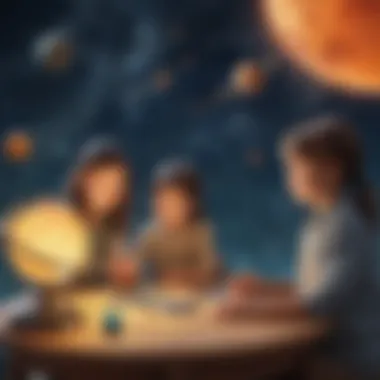Engaging Young Minds: Teaching the Solar System


Intro
Introducing children to the solar system can ignite a lifelong curiosity about the universe. Early exposure to the wonders of celestial bodies helps cultivate critical thinking and observational skills. This approach enhances their understanding of basic scientific concepts while fostering an appreciation for astronomy.
Educators and parents play a vital role in this developmental process. Effective methodologies and engaging resources can transform the complex universe into captivating material tailored for young minds.
The following sections outline interactive learning games, educational topics, practical tips, and creative DIY projects. Each section is designed to provide a comprehensive guide for those looking to inspire a new generation of young astronomers with hands-on learning experiences and fun activities.
Interactive Learning Games
Learning games serve as powerful tools for making education enjoyable. They can help kindergarteners understand the solar system in an interactive way. By participating in games, children can grasp fundamental concepts related to space and its various entities.
Popular Games
Among the most popular games for teaching about the solar system are:
- Solar System Explorer
- Space Quest
- Galactic Scavenger Hunt
Description of top educational games
- Solar System Explorer allows children to navigate through the solar system. They learn about planets, asteroids, and comets. This game combines visuals with informative tidbits about each celestial body.
- Space Quest is an adventure-based game where children complete missions related to different planets. As they progress, they encounter real facts about planetary characteristics.
- Galactic Scavenger Hunt provides children with clues related to space. They must search for items that represent different planets, which fosters recall of previously learned material.
Benefits of playing educational games for kids' cognitive development
Playing educational games encourages:
- Enhanced problem-solving skills.
- Improved memory and retention of facts.
- Collaborative skills through team-based tasks.
Game Reviews
In-depth reviews of selected educational games
- Solar System Explorer
- Space Quest
- Galactic Scavenger Hunt
- Gameplay: Features engaging activities and rich visuals. Easy to follow for young children.
- Learning Outcomes: Strong grasp of the solar system structure.
- Gameplay: Offers missions that require critical thinking. Suitable for group play.
- Learning Outcomes: Improved knowledge of planetary facts and differentiation.
- Gameplay: Interactive and fun. Encourages physical activity and discovery.
- Learning Outcomes: Reinforces learning in an enjoyable setting.
Comparison of gameplay and learning outcomes
In summary, while each game offers a unique approach to learning, the core benefit remains consistent: all reinforce knowledge about the solar system while enhancing cognitive skills effectively.
Educational Topics
Exploring a variety of educational topics can further an understanding of the solar system. Interdisciplinary learning connects science with math, art, and language.
Importance of interdisciplinary learning for holistic development
Children learn best when concepts are interconnected. For instance, counting planets introduces basic mathematics, while drawing celestial bodies enhances artistic expression. This integration fosters an all-round development crucial for young learners.
Tips and Tricks
Practical advice can significantly enhance the learning journey.
- Use visuals like posters of the solar system.
- Read engaging books about space.
- Organize outdoor stargazing sessions with children.
Strategies for making learning fun and engaging
Make use of storytelling techniques. Share captivating space tales or myths related to the night sky. Creating a space-themed learning environment can also boost engagement.
Creative DIY Projects
Hands-on activities allow children to actively participate in their learning process. By creating something tangible, they internalize knowledge about the solar system.
Step-by-Step Guides
One exciting project can be constructing a model of the solar system. Here is how to do that:
- Gather materials: Styrofoam balls, paints, and markers.
- Paint each ball to represent different planets.
- Create a structure (like a large cardboard base) to arrange the planets in order.
Benefits of hands-on activities for children's cognitive and motor skills
Engaging in DIY projects supports fine motor skills development while allowing children to express creativity. They also foster a sense of achievement upon completing a project.
Craft Ideas


Simple craft ideas include:
- Making planet mobiles using lightweight materials.
- Designing a solar system bracelet with colored beads.
Importance of artistic expression in children's development
Artistic activities help in cognitive development, encouraging children to think critically while offering them opportunities to express themselves.
Introducing the solar system to young learners is a profoundly enriching experience. Using games, interdisciplinary learning, practical tips, and creative projects makes the journey fun and effective in fostering a true interest in astronomy.
Prelims to Solar System Studies in Kindergarten
Introducing the solar system to kindergarten-aged children plays a valuable role in their development. Early astronomy education can ignite curiosity and foster a sense of wonder about the universe. It is important to approach this subject in a way that is engaging and accessible to young minds. By integrating solar system studies into the kindergarten curriculum, educators and parents can lay the groundwork for future scientific exploration.
Importance of Early Astronomy Education
Early exposure to astronomy can significantly benefit children's cognitive and social development. Understanding complex concepts, like planetary motions and celestial bodies, helps children enhance their critical thinking skills. Engaging with the solar system cultivates creativity and imagination through storytelling about planets and their characteristics. Moreover, it promotes collaboration with peers as they ask questions and share discoveries.
There are several reasons why early astronomy is essential:
- Stimulates Interest in Science: Introducing children to the wonders of the solar system can create a lasting fascination with science and exploration.
- Development of Early Literacy Skills: Engaging with astronomy-themed stories can improve vocabulary and comprehension.
- Enhancement of Problem-Solving Skills: Studying the solar system challenges children to think critically and develop solutions for questions about space.
"A child's wonder in the universe can inspire a lifelong pursuit of knowledge."
Overview of Solar System Components
The solar system consists of various components that can be intriguing for young learners. Each component has unique characteristics and plays a distinct role in the broader universe. For instance, the sun is the central star, and its energy sustains life on Earth. The planets, moons, asteroids, and comets each tell a story that can captivate young minds. Educators can use simple, relatable explanations to define these components and their interactions.
Key components of the solar system include:
- The Sun: This is more than just a bright object in the sky; it is a huge ball of gas that provides light and warmth.
- Planets: Each planet offers unique features. For example, Earth is known for its life, while Mars is often called the "Red Planet" for its color.
- Moons: Some planets have moons that orbit around them, adding another layer of complexity to space studies.
- Asteroids and Comets: They are remnants from the solar system's formation, providing history about its development.
By imparting knowledge of these components, educators can not only spark interest but also empower children to ask questions and seek answers.
Child Development and Astronomy
The intersection of child development and astronomy offers a significant opportunity for young learners. Introducing concepts of the solar system at an early age not only stimulates children’s imagination but also nurtures their cognitive and social skills. This process prepares them for critical thinking and problem-solving as they understand complex celestial phenomena. Engaging children with astronomy fosters a deeper appreciation for science, which can lead to lifelong learning and curiosity about the universe.
Cognitive Growth Through Astronomy
Cognitive growth in children is closely linked to their exposure to new ideas and experiences. Astronomy serves as a perfect springboard for deepening their understanding of the world. Children, especially in kindergarten, are naturally curious. When educators present the solar system in an accessible way, they help children develop essential skills. Through storytelling about planets and the sun, kids learn to categorize and synthesize information. Such activities enhance their memory, observational skills, and the ability to ask questions.
Engaging children with astronomy also encourages them to make connections between concepts. For instance, the relationship between day and night introduces them to cycles, which is fundamental in science. By understanding how the sun affects their daily lives, they develop spatial awareness and learn to appreciate patterns in nature.
Encouraging Curiosity and Discovery
Curiosity is an important driver of learning in young children. When they explore astronomy, their sense of wonder grows. Various learning strategies can promote this discovery process.
- Questions and Exploration: Encouraging children to ask questions about the stars, planets, and the universe taps into their innate need to learn. Providing them with opportunities to observe, whether through looking at the night sky or using simple telescopes, can ignite their passion for discovery.
- Hands-On Experiments: Simple activities, such as creating models of the solar system, encourage imaginative play and exploration. Such methods help children think critically about sizes, distances, and the relationships between celestial bodies.
- Connect with Nature: Taking children outside to stargaze or visiting planetariums can significantly enhance their enthusiasm. Direct engagement with the natural world fosters a sense of awe, prompting them to want to learn more.
In summary, incorporating astronomy into early childhood education supports cognitive development while sparking curiosity. It equips children with skills and knowledge that serve as a foundation for future educational pursuits.
Effective Teaching Strategies
The topic of effective teaching strategies is crucial in the realm of early childhood education, particularly when introducing complex subjects like astronomy. By employing the right methods, educators can enhance engagement and comprehension among kindergarten students. Effective teaching strategy helps educators create interactive and meaningful learning experiences. When working with young learners, the following strategies can profoundly influence how they understand and retain knowledge about the solar system.
Utilizing Visual Aids
Visual aids are essential in teaching kindergarten students about the solar system. Young children often respond better to visual stimuli than abstract concepts. For instance, brightly colored charts featuring planets can aid recognition and retention. Images and models of celestial bodies provide clarity. Moreover, using tools such as globes or augmented reality apps can turn the solar system into a tangible experience.
Classroom displays showcasing planets with their characteristics can also serve as constant reminders, reinforcing learning.
"Visual aids stimulate curiosity among young learners, prompting them to explore further."
Hands-on Activities and Experiments
Hands-on activities offer children a chance to engage directly with learning materials. These activities create memorable moments tied to educational content. For example, building models of the solar system using craft materials can aid in understanding size and distance. Simple experiments, like simulating gravity using balls of different sizes, allow children to grasp these concepts at a basic level.
Incorporating movement, such as a "planet dance" where children mimic the movements of celestial bodies, can also enhance engagement. Not only do these activities help in understanding facts, but they also promote motor skills and teamwork. When learners can touch, feel, and move, they are more likely to remember what they learn.
Incorporating Technology
Technology offers innovative ways to explore the solar system effectively. Various educational apps designed for young children can make astronomy fun and accessible. Interactive games that allow children to navigate through the solar system, or watch short videos about planets, can capture their interest.
In classrooms, smart boards can be utilized for interactive lessons that involve drawing or labeling planets. This medium allows for immediate feedback, enhancing the learning process. Technology also makes it possible to connect with virtual planetariums, offering experiences beyond the classroom. With these approaches, children engage in multi-sensory learning, which caters to different learning styles.
By integrating these effective teaching strategies, educators can foster a lasting interest in astronomy, laying the foundation for future scientific exploration.


Celestial Bodies: An Overview
Understanding celestial bodies is a key component of solar system studies aimed at kindergarteners. This topic helps young learners recognize and differentiate between various objects in space, such as stars, planets, moons, and comets. By introducing these concepts early, educators set the stage for a lifetime of learning and curiosity about the universe.
Understanding the Sun
The Sun is the star at the center of our solar system. It is vital for life on Earth. Young children can learn that the Sun provides light and warmth. Understanding the Sun's significance will help children appreciate more complex ideas later, like energy and ecosystems. Teachers can show pictures of the Sun and explain its role as the primary source of light. Simple activities, such as drawing a picture of the Sun or singing songs related to day and night, will reinforce these concepts.
The Planets of the Solar System
The planets in our solar system are fascinating subjects for young minds. There are eight recognized planets: Mercury, Venus, Earth, Mars, Jupiter, Saturn, Uranus, and Neptune. Children can learn simple facts about each planet. For example, Earth is where we live. Jupiter is the largest planet. Educators can use artwork as well as models to represent the planets’ size and appearance. Simple games or songs can teach their names and order. This interactive approach helps memory retention and makes learning enjoyable.
Moons, Asteroids, and Comets
Moons, asteroids, and comets introduce diversity beyond just planets. Children can grasp that many planets have moons. Earth has one, while Saturn has many. Learning about asteroids and comets can spark interest in how objects travel in space. Educators should consider stories that explain these bodies in a relatable way. For example, tales about comets bringing messages can fascinate children. Interactive activities, like making models from play dough, can also enhance understanding.
Understanding celestial bodies invites children to look up at the night sky with wonder and excitement.
Creative Learning Resources
Creative learning resources play a vital role in introducing the solar system to kindergarten-aged children. These tools not only stimulate their curiosity but also enhance comprehension of complex concepts. Young learners benefit most when information is presented in a dynamic and engaging format. Effective resources simplify this process, providing children with opportunities to explore outer space through various interactive and imaginative means.
Ultimately, a combination of different types of resources is ideal. Each variety offers unique advantages that cater to the diverse needs of young learners. Here are several categories of creative learning resources that can effectively enhance astronomy education:
Books and Illustrated Guides
Books and illustrated guides serve as foundational tools for teaching about the solar system. They offer colorful images and engaging narratives, making the vastness of space accessible to young minds. Titles such as "There's No Place Like Space" from Dr. Seuss and "The Darkest Dark" by Chris Hadfield combine storytelling with informative content. These books can spark children's interest in outer space and nurture their imaginations, inviting questions and discussions about celestial bodies.
Benefits of Using Books Include:
- Engaging Visuals: Images aid in retention and understanding.
- Narrative Structure: Stories are easier to follow than abstract facts.
- Language Development: Exposure to new vocabulary supports language skills.
Interactive Websites and Apps
In today's digital age, interactive websites and apps have become essential resources. Platforms like NASA's Eyes on the Solar System allow children to explore the planets and learn about missions in a fun and interactive way. These digital tools can keep children engaged for longer periods, as they often include games, quizzes, and animations that illustrate complex topics in an entertaining format.
Key Considerations for Interactive Tools:
- User-Friendly Interface: Young children need simple navigation.
- Educational Value: Ensure content is age-appropriate and informative.
- Engagement Level: Look for features that motivate exploration and learning.
Videos and Documentaries for Kids
Several educational videos and documentaries are tailored specifically for children. Series like "Cosmic Kids" and documentaries from National Geographic present information in a captivating manner. These videos utilize animations, storytelling, and engaging visuals to explain astronomical concepts. Viewing can aid retention and spark inquiries that lead to deeper understanding.
Effective Video Features:
- Visual Explanation: Combine narration with illustrations.
- Short Duration: Young attention spans benefit from brief content.
- Relevance to Curriculum: Limit content to what aligns with educational goals.
Overall, utilizing varied resources can vastly enrich the learning experience, ensuring that young learners develop an early passion for astronomy. Embracing a mix of books, interactive tools, and videos prepares children for a lifetime of curiosity about their universe.
Integrating the Solar System into Daily Activities
The integration of the solar system into daily activities serves a crucial role in reinforcing the lessons young children learn in the classroom. Astronomy does not need to be confined to textbooks or structured lessons. By including it in everyday experiences, educators and parents can make learning more relatable and engaging for kindergarten-aged children. This approach nurtures their natural curiosity and fosters a profound love for the cosmos.
Involving children in solar system-related activities encourages exploration and enhances cognitive development. It also provides an opportunity to practice skills such as creativity, observation, and problem-solving. When children encounter new concepts in a familiar context, they are more likely to retain the information. Additionally, integrating space themes into their routine can spark imaginative thinking and discussion among peers and families, creating a collaborative learning environment.
Crafts and DIY Projects
Crafts and DIY projects are excellent tools for grasping complex astronomical themes in a tangible manner. Simple projects, like creating paper models of planets or designing a solar system mural, provide children with hands-on experience. These activities can enhance fine motor skills and creativity in a fun and engaging context.
Here are a few craft ideas to try:
- Planetary Mobiles: Use paper plates, paints, and string to create a mobile of the solar system. Each planet can be crafted with unique colors and features.
- Space Slime: Make homemade slime and add glitter to represent stars. This experience blends science with creativity.
- Rocket Launchers: Create small rockets using paper cones and straws. Kids can launch them to see which design flies the highest.
These projects stimulate imagination and can be incorporated into family time or classroom settings, thus reinforcing solar system concepts through enjoyable interaction.
Outdoor Exploration and Observation
Outdoor exploration presents a unique opportunity to observe celestial bodies and apply learned knowledge practically. Stargazing can foster a deeper understanding of the universe. It invites discussions about stars, planets, and constellations, enriching the educational experience.
Parents and educators can organize night sky observation sessions. Here are some suggestions:
- Stargazing Nights: Bring a telescope or simply lie on blankets to view the night sky. Identify constellations and planets visible to the naked eye.
- Nature Walks: While outside, encourage children to look for natural features that resemble celestial bodies, like round rocks representing planets.
- Sun and Shadows: Use sunny days to learn about the sun's position. Create shadow art by placing objects on paper and tracing around them as the sun changes position.
This type of activity links astronomy with the environment, helping children understand their place in the universe through direct engagement with nature.
Role-playing and Storytelling


Role-playing and storytelling allow children to embody characters and scenarios, offering a dynamic way to explore astronomical concepts. By acting out the roles of astronauts or scientists, children can deepen their understanding of space travel, exploration, and the various elements of the solar system.
Here are ways to implement this:
- Dress-Up Space Adventures: Create imaginary space missions where children can dress as astronauts. This helps spark creativity and brings their learning to life.
- Story Telling Sessions: Read books related to space or encourage children to create their own stories about adventures in the solar system. This encourages language development and narrative skills.
- Space Exploration Games: Develop games where children can simulate landing on different planets and learning their unique features. This could involve simple board games or interactive storytelling.
Role-playing supports cognitive development by allowing children to use their imagination and apply concepts in an engaging way.
Encouraging solar system learning through daily activities is a vital step in nurturing interest in astronomy. Practical applications help retain knowledge and stimulate curiosity.
By incorporating solar system themes consistently into daily life, educators and parents can create a rich learning environment, cultivating young minds that are fascinated by the mysteries of the universe.
Assessing Knowledge and Engagement
Assessing knowledge and engagement is crucial in a kindergarten setting focused on the solar system. Young learners are naturally curious about their environment, and introducing them to astronomy can significantly stimulate this curiosity. It is essential to evaluate not only what children learn but also how engaged they are in the learning process. By implementing effective assessment strategies, educators can adapt their methods to better cater to the needs and interests of young learners.
Effective assessment involves observing students during activities and discussions. This observational approach provides insight into each child's understanding and excitement about the subject. Monitoring participation and enthusiasm during lessons can offer clues to how well they are absorbing the material. Engaged children are more likely to retain knowledge and develop a lasting interest in astronomy.
Moreover, assessing engagement encourages educators to create a dynamic learning environment. As educators notice what captures their students' attention, they can tailor future activities to align with these interests, ensuring that learning remains enjoyable and impactful. This adaptability not only enhances comprehension but also fosters a sense of ownership in the learning process among young students.
"Education is not the filling of a pail, but the lighting of a fire."
- William Butler Yeats
Observation Techniques for Educators
Observation techniques are integral to understanding how children interact with concepts of the solar system. By employing systematic approaches, educators can better grasp the learning process occurring in their classrooms.
- Anecdotal Records: Keeping brief, written accounts of children's comments and actions during lessons helps monitor their progress. This record can identify trends in their understanding of the solar system, such as their interest in planets or moons.
- Checklists: Creating checklists aligned with the learning objectives allows educators to note which concepts children grasp easily and which require more focus. These can help track understanding over time.
- Interactive Discussions: Facilitating open conversations about the solar system lets children express their thoughts. During these discussions, it’s possible to gauge their fascination and comprehension.
Incorporating these techniques into daily routines can enhance not only assessment practices but also teach children the value of reflection on their learning.
Creative Feedback Mechanisms
Providing creative feedback mechanisms is essential for reinforcing learning about the solar system. Feedback helps children understand their strengths and areas for improvement, promoting a growth mindset.
- Verbal Praise: Recognizing efforts and achievements verbally can boost children's confidence. Simple phrases like "Great job finding out about Jupiter!" encourage further exploration.
- Visual Feedback: Using stickers, stamps, or drawings that relate to the solar system can make feedback more engaging. Children may find it exciting to receive a star sticker for learning a new fact about Saturn's rings.
- Peer Feedback: Encouraging children to share what they learned with peers fosters collaboration. This method facilitates creative expressions of thoughts, enhancing their engagement.
- Reflective Journals: Letting children maintain a simple journal can empower them to articulate what they learn. This practice not only reinforces their understanding but also provides a resource for parents and educators to see their progress.
Through varied feedback mechanisms, educators can create a positive learning experience that encourages continual interest in the vastness of the universe.
Finale: The Lasting Impact of Early Astronomy Education
Early astronomy education holds profound significance for kindergarten children. It shapes not only their academic pursuits but also their understanding of the world and beyond. Children developed a sense of wonder when they learn about the solar system. This feeling can motivate them to ask questions and seek answers. Such curiosity is crucial in a citizen's life.
Benefits of Early Exposure
Introducing young learners to concepts of space and celestial bodies offers various benefits. Most importantly, it enhances cognitive development. Children start to learn basic scientific principles and encourage critical thinking. They grasp the mechanics of planetary motion and the uniqueness of each planet. Moreover, they also develop spatial awareness. This lays a strong foundation for future studies in science, mathematics, and even art.
Social and Emotional Growth
Children begin forming their perspectives about the universe. When learning about the solar system, they often engage in group activities. These collaborative initiatives foster teamwork and communication skills. Also, it can build friendships among classmates as they explore concepts together. The social bonds formed in these educational settings remain with them.
Considerations for Educators and Parents
Caregivers and teachers must be mindful of the vast diversity of students. Not all children assimilate information at the same rate. Thus, it is vital to provide various resources tailored to different learning styles. Incorporating visual aids, hands-on activities, and storytelling can engage multiple senses. This approach ensures that every child can participate and feel included in these activities.
"Early education in subjects like astronomy nurtures inquisitive minds ready to explore the mysteries of the universe."
In summary, the lasting impact of early astronomy education is multifaceted. It promotes intellectual curiosity, enhances social interaction, and sparks a lifelong interest in science. This foundation not only prepares children for academic challenges but also empowers them to venture beyond their immediate environments. By investing in early astronomy education, we prepare our future leaders to look up, question, and innovate in a world full of possibilities.
The universe awaits, and our youngest learners are essential for unlocking its mysteries.
Further Reading and Resources
Understanding the solar system is just the beginning for young learners. Further reading and resources open up new paths for curiosity and deeper engagement. They provide essential support for parents and teachers who wish to expand children's knowledge of astronomy. The inclusion of various materials can help create a rich learning environment, fostering enthusiasm about the universe.
Importance of Further Reading
By integrating books, articles, videos, and interactive materials into lessons, educators can enrich their teaching. Children learn best when they can explore concepts through multiple forms of media. Here are some key reasons why further reading is crucial:
- Diverse Learning Avenues: Reading materials allow children to interact with information in different ways, catering to various learning styles.
- Increased Vocabulary: Exposure to new words and concepts helps to improve language skills.
- Encourages Independent Exploration: Access to various resources empowers children to seek knowledge on their own, promoting independence in learning.
Teachers and parents can make use of recommendations that are age-appropriate and engaging. Selecting books with illustrations about planets or videos that show the solar system in action fosters a sense of wonder.
Recommended Resources
Here are several resources parents and educators might consider:
- Books: "There’s No Place Like Space: All About Our Solar System" by Tish Rabe is an excellent choice. It engages children with fun rhymes and illustrations.
- Websites: National Aeronautics and Space Administration (NASA) has educational resources tailored for young audiences, providing accessible information and interactive tools.
- Videos: Platforms like YouTube offer many educational channels that explain astronomy concepts engagingly.
"Learning about the solar system can inspire a lifetime of curiosity and discovery in children."
Considerations for Choosing Resources
While selecting materials, several factors should be considered:
- Age Appropriateness: Ensure that the content is suitable for kindergarten-aged children. The language should not be too difficult or abstract.
- Interactive Elements: Look for books or websites that encourage interaction. Activities or experiments can enhance engagement.
- Visual Appeal: Children respond well to colorful images and engaging visuals. Choose materials that capture their attention.
In summary, further reading and resources play a vital role in expanding a child's understanding of the solar system. By choosing thoughtful materials, parents and educators can nurture young minds, inspire curiosity, and instill a passion for learning more about the universe.















